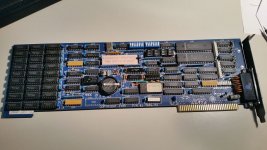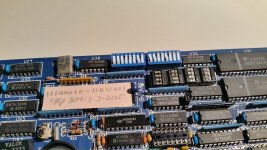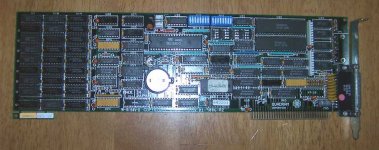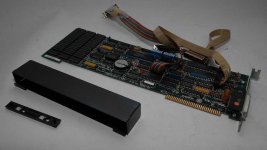MauriceH
Experienced Member
Have Quadram Silver 01-9006-R2.
Posted here before some issues with this card but that is all solved by now.
It is a card with 384k Mem , 2x serial, 1x Parallel, 2x game (1x 15pin).
After a deep debug on the hardware I manage to construct the 2 serial ports and the game port (the DIL connection).
I also manage to configure the card so it recognise the mem correct and the ports. (MBoard 256k+384k makes 640k works perfect)
That all working now.
BUT, still no function of the game port at all.
Also games will not recognise a installed game port.
It's a IBM 5160 with a 1982 BIOS, and checked with an other gameport card if the bios will work.
That is the case.
With that card in a simple DOS quest game the crtl-j will function. BOX come up to adjust the joy-stick.
But on the Quadram Silver card Crtl-J it will not function at all and no box appear even.
The manuals Quadram on the I-net will not compare with my card.
I figured out all sw-settings till game port, I have to guess.
Can witch on-off the com ports ans LPT.
Also there is a jumper, that will have no effect.
Tried several swtch settings but the game port will not activate.
QUESTION.
There are 4 1-time adjustable block, cut-out ones.
What could they mean?
On the I-net I find 1 picture of similar card and seems to be the same configuration of those 4 cut-out blocks.
1 1 0 0
0 0 1 1
0 0 1 1
1 1 0 0
My card and details of sw and blocks.


And this I found on the Internet, Blocks seems to be same cut-outs

and a second picture found

Posted here before some issues with this card but that is all solved by now.
It is a card with 384k Mem , 2x serial, 1x Parallel, 2x game (1x 15pin).
After a deep debug on the hardware I manage to construct the 2 serial ports and the game port (the DIL connection).
I also manage to configure the card so it recognise the mem correct and the ports. (MBoard 256k+384k makes 640k works perfect)
That all working now.
BUT, still no function of the game port at all.
Also games will not recognise a installed game port.
It's a IBM 5160 with a 1982 BIOS, and checked with an other gameport card if the bios will work.
That is the case.
With that card in a simple DOS quest game the crtl-j will function. BOX come up to adjust the joy-stick.
But on the Quadram Silver card Crtl-J it will not function at all and no box appear even.
The manuals Quadram on the I-net will not compare with my card.
I figured out all sw-settings till game port, I have to guess.
Can witch on-off the com ports ans LPT.
Also there is a jumper, that will have no effect.
Tried several swtch settings but the game port will not activate.
QUESTION.
There are 4 1-time adjustable block, cut-out ones.
What could they mean?
On the I-net I find 1 picture of similar card and seems to be the same configuration of those 4 cut-out blocks.
1 1 0 0
0 0 1 1
0 0 1 1
1 1 0 0
My card and details of sw and blocks.


And this I found on the Internet, Blocks seems to be same cut-outs

and a second picture found

